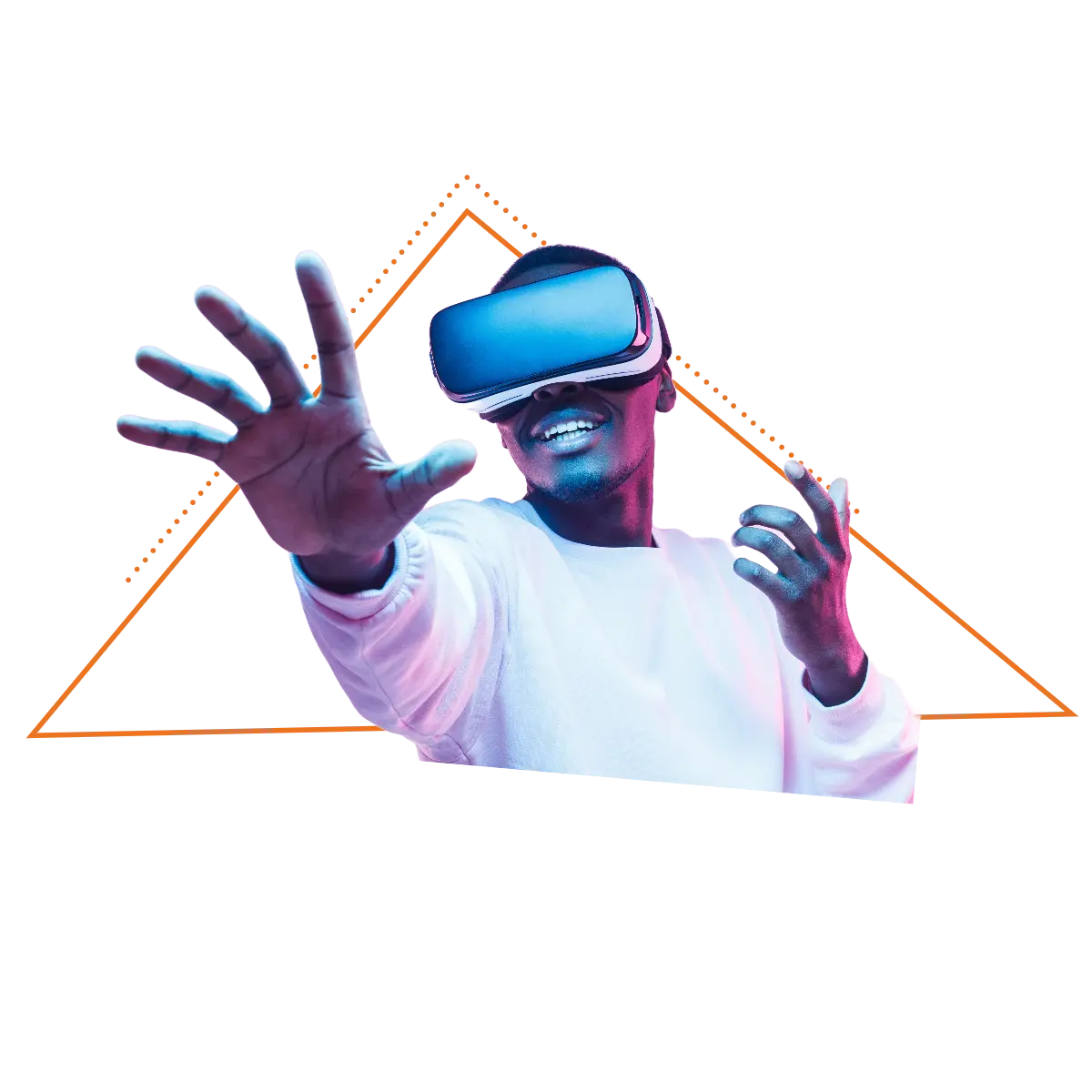
The technology industry is exciting and continuously shifting, and even a short period of a few months can bring dramatic changes.
Three of AIM’s leadership team members shared their key projections at the start of 2023. We checked in with them halfway through the year to assess what aligns with their predictions, and the technology sector transformations that no one could have seen coming.
We also surveyed 100 technology leaders to understand organizations’ most significant priorities, challenges, and strategies in 2023 and beyond. Download your free copy of our Tech Trends eBook below to learn from the results!
Meet our experts:
- Kyle Mizell – Senior Vice President of Consulting Services
- Patrick Taylor – National Technology Evangelist
- Jeff Rubingh – National Director, Digital Experience
Tech Trends of 2023
- Growth of Generative AI and ChatGPT
- Cloud Solutions Moving Up the Stack
- Augmented Reality and Virtual Reality
- The Startup Boom
- Recession and Team Resizing
- Synthetic Test Data
- Growth of Cloud Native
- DevOps Automation at the Enterprise Level
- Zero-Trust Architecture
- Data Repatriation

White Paper
2023 Tech Trends Insights
We polled technology leaders to uncover trends in the tech outlook for the remainder of 2023 and beyond. Download the white paper to learn from their strategies and insights.
Download your copy today!
Growth of Generative AI and ChatGPT
“Even when we projected generative AI as a key trend at the start of 2023, we could have never predicted how quickly it would become integrated into just about every product and platform,” Mizell said.
“There has been a tremendous upflow in understanding Generative AI this year,” Rubingh echoed. “OpenAI’s ChatGPT has taken the world by storm; it’s one of the biggest changes that has occurred in the technology world in the past 20 years.”
Rubingh highlighted the diverse array of AI applications, spanning from product design and prototyping to crafting personalized user interfaces, simulating financial situations, optimizing supply chains, and advancing drug discovery and design. He anticipates consistent growth in its adoption across various sectors.
Another incredibly impactful change that put even more fuel on this fire of Generative AI came out of Microsoft Build 2023.
“Microsoft is looking at Copilot as a platform that will enable everyone to create rich AI experiences. This strategy is way ahead of any other player in technology today. The opportunity for AI to be included in absolutely every experience and customized for specific uses will usher in a new era in how technology can improve our lives,” Taylor said.
“Thinking of copilots as a platform is a very big deal. It will take some time, and that time will be measured in years, but it will radically transform people’s experience and the industry as a whole.”
“Microsoft is not dominating the space; Microsoft is defining the space. Microsoft’s strategy and their proven experience in knowing how to build platforms mean they are going to do other things that other players – Google’s Bard, Open AI’s ChatGPT, and others – weren’t even thinking about.”
With great power comes great responsibility, and Generative AI is no exception. Our survey found that 32% of tech industry leaders are somewhat concerned about employees sharing private corporate data with ChatGPT and other generative AI platforms; an additional 32% are very concerned.
Cloud Solutions Moving Up the Stack
“Copilot as a platform is an excellent example of cloud solutions moving up the stack,” Taylor said. “You want to do AI? Don’t worry about training your model, you’re not a data scientist – you’re an application architect. You can use their data, bring a bit of your own data, throw your API on it, and build something fast.”
He elaborated, “We no longer have to think about AI studio and which algorithm was used in training. Instead, we say, here’s a copilot, here’s my data, here’s my safety that I want to build in, I want it to spit out in this format, etc. It’s going to take a while, but that’s because it’s massive.”
Augmented Reality and Virtual Reality
The most significant transformation in the Augmented Reality (AR)/Virtual Reality (VR) space in the first half of 2023 was Apple’s introduction of the Vision Pro. “I think Apple hit a home run; this is probably the most transformative new product that Apple has put out since the iPhone,” expressed Rubingh.
The $3500 price tag for the Vision Pro caused significant buzz, given that it far surpasses the cost of the $500 Meta’s Quest 3 headset and the $550 Sony PlayStation VR2. Although Apple’s Vision Pro announcement garnered the most attention in the space, competitors managed to benefit from it.
“Apple’s good at validating ideas. When Apple releases a product or even announces a product in development, it validates the space, and all of the other players get a lift from that,” Mizell explained. “I think AR/VR as a whole will get a huge lift in the second half of the year, in large thanks to Apple’s announcement.”
Rubingh compares the adoption of AR/VR headsets to the adoption of the iPhone, which was introduced to the market in 2007 but didn’t start gaining momentum until the end of 2010. He acknowledged that Apple isn’t projecting significant sales yet and we won’t see widespread adoption for a while.
During the iPhone movement, other feature players – Nokia, Blackberry, Microsoft – fell away. Rubingh projects that Apple’s introduction of the Vision Pro could have a similar effect on Meta.
“Apple took all of the oxygen out of the room, and Zuckerburg has a lot to think about and figure out how to compete,” mused Rubingh. “Maybe [Meta will produce] more of a blue-collar device, primarily for gamers, whereas Apple is for productivity and an entirely new platform.”
“[The release of the Vision Pro] might validate the space, but it also might scare away all of the competitors, because how are you going to compete with a $3500 device that does everything?”
The Startup Boom
“One of the biggest changes over the last year has been basically the end of ‘free money.’ For a long time, interest rates were incredibly low. That’s no longer true. Money is no longer free, which has caused a startup slowdown,” explained Rubingh.
Global VC funding reached $88 billion in Q1 2023 and $81 billion in Q2 2023. In comparison, $182 billion and $139 billion of venture capital were invested in Q1 and Q2 of 2022, respectively.
“I think people are too scared with today’s current economy and I think the financial environment has not settled out enough [to set the stage for a startup boom],” said Taylor.
The only exception to this rule, Rubingh and Taylor noted, is AI startups. Startup investing in generative AI has rapidly increased in 2023, and the AI market size is projected to reach a stunning $407 billion by 2027. This is astounding growth from its market size of just $86.9 billion last year.
Perhaps even more remarkable is its projected impact on economic growth. Research indicates that generative AI could contribute the equivalent of $2.6 trillion to $4.4 trillion annually to the global economy.
“It’s kind of this Dickensian world: It’s the best of times and the worst of times in the startup world,” shared Rubingh.
Recession and Team Resizing
This year has been an incredibly difficult one for tech employees. In the first half of the year, a jarring 213,334 tech employees were laid off.
“Across the board, big companies are having large layoffs. Downsizing has been categorized by some as necessary – they were too bloated, they over-hired in 2022, as well as other reasons. Some are true, some are to please investors,” Mizell shared.
Although the sheer number of layoffs feels bleak, there may be light at the end of the tunnel. In AIM’s recent survey of technology industry leaders, only 11% of respondents shared plans to reduce their workforce in the second half of 2023. In comparison, 26% plan to maintain current headcount and 58% have hiring plans.
One aspect of team resizing that is seldom given proper attention is the increased workload and responsibilities of the remaining teammates. Taylor advised that managers should be incredibly mindful of this.
“Accommodating change is work, and that’s increasing the load on your teams,” he shared. “Organizational change management can help teams adjust to that change in workload and structure more intentionally.”
Synthetic Test Data
At the beginning of 2023, Mizell said that the next evolution in software testing, security, and privacy concerns was using synthetic test data built by AI. Synthetic test data addresses the far-too-common problem of organizations having sensitive data in their less secure, pre-production environments.
The thing no one foresaw at the start of this year was how Generative AI would skyrocket in capability and popularity, and how it would streamline the generation of synthetic test data.
“Automation testing and software testing is being advanced by using things like Generative AI, building things into our development environments to test more effectively and fluidly.”
Growth of Cloud Native
“We know the growth of cloud native is a long-term trend. Applications that would have been built lift-and-shift are being built more native to the cloud. There’s also the long-tail of [cloud providers like] Linode, Cloudflare, and DigitalOcean,” explained Taylor.
Although Taylor noted he is not seeing as much movement in longtail offerings as he initially expected at the beginning of the year, he stands by the long-term forecast of the trend.
“Keep an eye on the non-big three players,” he advised, referring to AWS, Azure, and GCP. “Second- and third-tier players will continue to gain prominence.”
Mizell added, “More and more companies are shifting to second- and third-tier cloud providers largely for cost savings. The more you move onto cloud-managed services, the more optimized you can make your spend, as well as take advantage of some great features.”
DevOps Automation at the Enterprise Level
Organizations are in the continuous pursuit of greater efficiencies, improved processes, and greater maturity, and DevOps automation is instrumental to achieving that.
In 2023, we’ve seen richer toolkits, including the availability of Azure Deployment Environments as part of Microsoft Build. Bicep, a domain-specific language (DSL) for deploying Azure resources, is gaining more attention.
“More competition and richer tooling will continue to enable better DevOps,” said Mizell.
Zero-Trust Architecture
Zero-trust architecture ensures that everybody must be authenticated. Organizations that are intent on protecting their sensitive internal data will benefit from implementing a zero-trust architecture that offers protection against internal and external threats.
“Zero-Trust Architecture wasn’t new for this year, but you see a greater emphasis on it,” shared Mizell. “It’s essential to business, and more businesses are continuing to invest in it because of the security implications if you don’t.”
Data Repatriation
Data repatriation is when organizations pull out of the cloud and move data into their own data centers. Storage costs for large-scale data sets and archives are high in any architecture, and some organizations want to trade out cloud costs by taking on storage responsibilities and risks.
Although this could be an alluring way for organizations to reduce cloud management costs down the line, it has not proven to be a major trend yet.
“Data repatriation at this point is fairly conceptional. It may be on organizations’ lists for potentials; if they have to figure out how to squeeze more money out of their spend, it might be a target for the future. But we haven’t seen much movement yet,” said Mizell.
Technology Transformation in 2023 and Beyond
When your organization looks to achieve your most ambitious initiatives across data, digital, and cloud, AIM Consulting can help. Our value is anchored in deep expertise in technology and a passion for empowering our clients’ growth and success.
Whether you’re looking to tighten security, increase the efficiency of your teams, or manage your cloud computing costs, our team is ready to partner with you and accomplish your goals.
Let’s Build the Future Together.
Whether you’re looking to join the AI revolution, optimize your cloud infrastructure to safeguard against cyberthreats, or leverage emerging technologies to gain a competitive advantage, we bring the technical expertise, tenacity, and custom-fit approach to transform your business.






